Itinerary
Basel is a city in northwestern Switzerland on the Swiss, French and German borders. It is located on the bend of the River Rhine and benefits from a Mediterranean climate. It is the third most populated city in Switzerland and has been the commercial hub for Swiss arts and culture since the Renaissance. In 1967 the people of Basel voted to acquire two paintings by Picasso, who was so moved by the Basel people that he donated 3 paintings and a study to the city’s Kunstmuseum (Museum of Fine Arts). Visit the Augusta Raurica, one of the largest Roman archaeology parks in Switzerland, and enjoy a river crossings over the River Rhine by non-motorised ferries. During the summer months, time is spent outdoors, either swimming in the River Rhine, dining al fresco, enjoying open air concerts, cinema, street parties and festivals. Basel is home to over 20 restaurants that have won GaultMillau or Michelin awards, and boasts Switzerland’s largest collection of theatre shows, including modern contemporary dance, touring and puppetry theatre.
Day programme:
BASEL, SWITZERLAND – EMBARKATION. Board your ship in Basel for your Christmas Markets on the Rhine cruise. (B)
Breisach is a town located in Southwest Germany on the French border. The town is situated in the Rhine Valley on the banks of the river Rhine and dates back over four thousand years. Breisach and its history can be experienced through the City History Museum, which houses a permanent exhibition taking you from Stone Age through the Celtic, to the Romans and Middle Ages, right up to modern day. St Stephen’s Cathedral is home to the city’s famous art treasures, the wheel wells, which are housed in the neighbouring Radbrunnenturm with the forty one metre deep water well. The cathedral is also home to many other treasures including the High Altar of Master HL and wall paintings by Martin Schongauer as well as High Gothic and Roman architecture. A visit to the Blue House, the former Jewish Community Centre, is highly recommended. Now owned by the Friends of Former Jewish Community House Breisach it exhibits memorials to Breisach’s Jewish heritage.
Day programme:
BREISACH, GERMANY. Breisach is your gateway to several different excursions. Journey into medieval Colmar, located in the enchanting Alsace region of France. Delight in the half-timbered houses lining the cobblestone streets as you take in the whimsical blend of French and German culture and the town’s wonderful Christmas Markets. Alternatively, you may wish to visit Freiburg, founded in 1120 and home to Freiburg’s Münster, a Gothic cathedral constructed of red sandstone, as well as its enchanting Christmas market. Those wishing a more active excursion will want to cycle through the scenic countryside. (B,L,D)
Day programme:
STRASBOURG, FRANCE. Strasbourg is even more alluring during the season of Advent. The Christkindelsmärik dates back to 1570, making it the oldest Christmas market in France. Enjoy a panoramic bus tour that takes you past the Parc de l’Orangerie, the European Parliament and the Place de la Republique. Afterwards, walk through the historic town center on the Grande Île, a UNESCO World Heritage Site, and through the lovely “La Petite France” district, where you will see the Cathédrale de Nôtre Dame with its famous astronomical clock and then visit the town’s famous Christmas market. You can also choose to explore Strasbourg’s different districts by bicycle. During the afternoon, visit Gengenbach Christmas market where, every year, the locals count down to Christmas with a 24-day, larger-than-life Advent calendar. (B,L,D)
Day programme:
LUDWIGSHAFEN, GERMANY – RÜDESHEIM, GERMANY. You have a choice of several excursions, depending on your interest. Visit Heidelberg, a perfectly preserved medieval city nestled in the Neckar River Valley along German’s Castle Road, followed by a visit to the Christmas markets. For those seeking a more active adventure, hike the historic Philosopher’s Path or bike along the shores of the river Neckar, ultimately arriving in the medieval town of Ladenburg. Alternatively, you can discover the medieval past of Speyer and its charming Christmas markets. Later in the day, sail to the winemaking town of Rüdesheim, where you can taste the village’s sweet wine or its special delight, Rüdesheimer coffee, ceremoniously made with whipped cream and brandy. (B,L,D)
Rudesheim am Rhine is a town in the Rhine Valley in Germany and part of the UNESCO World Heritage Site of Rhine Gorge. It is known for its production of Riesling wine and has been popular for its wine making since ancient times. The Medieval Bromserburg Castle is home to the Rheingau Wine Museum and wine is a crucial part of Rudesheimer culture. The town is surrounded with vineyards and wineries, as well as many local wine bars and seasonal wine taverns. Wine tasting is a must do in Rudesheim and dining out is a great accompaniment. The local cuisine is seasonal and is closely intertwined with the wine growing traditions together with soups such as Zwiebelkuchen, Handkäs mit Musik and Spundekäs. Nordic Walking is popular around town, with five adventure trails around the vicinity, as well as many popular cycling routes. Great views of the town can be found from the water, the cable car to Niederwald Monument and the Monument itself. Old Town has the best examples of the town’s architecture with Eagle Tower, Oberstrasse and Rheinstein Castle some key sites to visit.
Rudesheim am Rhine is a town in the Rhine Valley in Germany and part of the UNESCO World Heritage Site of Rhine Gorge. It is known for its production of Riesling wine and has been popular for its wine making since ancient times. The Medieval Bromserburg Castle is home to the Rheingau Wine Museum and wine is a crucial part of Rudesheimer culture. The town is surrounded with vineyards and wineries, as well as many local wine bars and seasonal wine taverns. Wine tasting is a must do in Rudesheim and dining out is a great accompaniment. The local cuisine is seasonal and is closely intertwined with the wine growing traditions together with soups such as Zwiebelkuchen, Handkäs mit Musik and Spundekäs. Nordic Walking is popular around town, with five adventure trails around the vicinity, as well as many popular cycling routes. Great views of the town can be found from the water, the cable car to Niederwald Monument and the Monument itself. Old Town has the best examples of the town’s architecture with Eagle Tower, Oberstrasse and Rheinstein Castle some key sites to visit.
Day programme:
RÜDESHEIM – RHINE GORGE SCENIC CRUISING – LAHNSTEIN, GERMANY. Visit Siegfried’s whimsical Mechanical Instrument Cabinet, take a guided bike tour through the town and along the Rhine River, hike through the vineyards or soar high above the town by gondola and later enjoy Christmas traditions from all over the world at Rüdesheim Christmas market. Later in the day, sit in the Main Lounge, out on your balcony or bundle up on the Sun Deck to enjoy a scenic cruise through the Rhine Gorge, during which you will see many historic castles. Upon reaching Lahnstein, take a unique tour of Lahneck Castle. (B,L,D)
Cologne is a city in western Germany located across the Rhine river. It is the oldest in Germany, dating back 2000 years and is considered the region’s cultural hub. The city is known for its iconic landmark of the twin-spired Cologne Cathedral set against the reconstructed Old Town buildings. When in Old Town, visit the historic Old Town Hall and the Roman Church Great St Martin, or take time out and sit at one of the traditional breweries and enjoy the scenery around you. Historical sites such as the Roman Dionysus mosaic and the medieval Overstolzenhaus are worth a visit too. Another iconic sight in Cologne is at Hohenzollern Bridge. Here, local and tourist couples affix padlocks to the railings of the bridge and swear their loyalty to each other, they then throw the key into the Rhein to ensure everlasting love. Cologne is home to over 30 stages providing cabaret, free ensembles, theatre and dance and also celebrates its openly gay culture.
Day programme:
DÜSSELDORF, GERMANY. Enjoy a scenic cruise into Düsseldorf. In the afternoon, take a brief trip to the nearby city of Cologne on a guided tour of its enchanting Old Town, where you will see sites such as the Cologne Rathaus, Germany’s oldest town hall; the Fishmarkt, which dates back to the 12th century and the Great St. Martin Church. Then visit one of Europe’s largest and most renowned Christmas Markets. Or explore historic Düsseldorf on foot with a knowledgeable local tour guide. Then, be treated to a tasting of Altbier, a clean and crisp beer developed in Düsseldorf that is crafted using traditional brewing techniques. Conclude the tour with a visit to the local Christmas Market. Alternatively, cover more ground with an active bike tour of the city. (B,L,D)
Amsterdam combines the unrivaled beauty of the 17th-century Golden Age city center with plenty of museums and art of the highest order, not to mention a remarkably laid-back atmosphere. It all comes together to make this one of the world’s most appealing and offbeat metropolises in the world. Built on a latticework of concentric canals like an aquatic rainbow, Amsterdam is known as the City of Canals—but it’s no Venice, content to live on moonlight serenades and former glory. Quite the contrary: on nearly every street here you’ll find old and new side by side—quiet corners where time seems to be holding its breath next to streets like neon-lit Kalverstraat, and Red Light ladies strutting by the city’s oldest church. Indeed, Amsterdam has as many lovely facets as a 40-carat diamond polished by one of the city’s gem cutters. It’s certainly a metropolis, but a rather small and very accessible one. Locals tend to refer to it as a big village, albeit one that happens to pack the cultural wallop of a major world destination. There are scores of concerts every day, numerous museums, summertime festivals, and, of course, a legendary year-round party scene. It’s pretty much impossible to resist Amsterdam’s charms. With 7,000 registered monuments, most of which began as the residences and warehouses of humble merchants, set on 160 man-made canals, and traversed by 1,500 or so bridges, Amsterdam has the largest historical inner city in Europe. Its famous circle of waterways, the grachtengordel, was a 17th-century urban expansion plan for the rich and is a lasting testament to the city’s Golden Age. This town is endearing because of its kinder, gentler nature—but a reputation for championing sex, drugs, and rock ’n’ roll does not alone account for Amsterdam’s being one of the most popular destinations in Europe: consider that within a single square mile the city harbors some of the greatest achievements in Western art, from Rembrandt to Van Gogh. Not to mention that this is one of Europe’s great walking cities, with so many of its treasures in the untouted details: tiny alleyways barely visible on the map, hidden garden courtyards, shop windows, floating houseboats, hidden hofjes(courtyards with almshouses), sudden vistas of church spires, and gabled roofs that look like so many unframed paintings. And don’t forget that the joy lies in details: elaborate gables and witty gable stones denoting the trade of a previous owner. Keep in mind that those XXX symbols you see all over town are not a mark of the city’s triple-X reputation. They’re part of Amsterdam’s official coat of arms—three St. Andrew’s crosses, believed to represent the three dangers that have traditionally plagued the city: flood, fire, and pestilence. The coat’s motto (“Valiant, determined, compassionate”) was introduced in 1947 by Queen Wilhelmina in remembrance of the 1941 February Strike in Amsterdam—the first time in Europe that non-Jewish people protested against the persecution of Jews by the Nazi regime.
Day programme:
AMSTERDAM, NETHERLANDS. Cruise the iconic canals of Amsterdam, considered the “Venice of the North” and admire the historic architecture along the way. Alternatively, taste local specialties at one of Amsterdam’s grand cafés. Please note that an alternative tour will depend on docking location. (B,L,D) *Please note an alternative tour will operate depend on docking location.
Amsterdam combines the unrivaled beauty of the 17th-century Golden Age city center with plenty of museums and art of the highest order, not to mention a remarkably laid-back atmosphere. It all comes together to make this one of the world’s most appealing and offbeat metropolises in the world. Built on a latticework of concentric canals like an aquatic rainbow, Amsterdam is known as the City of Canals—but it’s no Venice, content to live on moonlight serenades and former glory. Quite the contrary: on nearly every street here you’ll find old and new side by side—quiet corners where time seems to be holding its breath next to streets like neon-lit Kalverstraat, and Red Light ladies strutting by the city’s oldest church. Indeed, Amsterdam has as many lovely facets as a 40-carat diamond polished by one of the city’s gem cutters. It’s certainly a metropolis, but a rather small and very accessible one. Locals tend to refer to it as a big village, albeit one that happens to pack the cultural wallop of a major world destination. There are scores of concerts every day, numerous museums, summertime festivals, and, of course, a legendary year-round party scene. It’s pretty much impossible to resist Amsterdam’s charms. With 7,000 registered monuments, most of which began as the residences and warehouses of humble merchants, set on 160 man-made canals, and traversed by 1,500 or so bridges, Amsterdam has the largest historical inner city in Europe. Its famous circle of waterways, the grachtengordel, was a 17th-century urban expansion plan for the rich and is a lasting testament to the city’s Golden Age. This town is endearing because of its kinder, gentler nature—but a reputation for championing sex, drugs, and rock ’n’ roll does not alone account for Amsterdam’s being one of the most popular destinations in Europe: consider that within a single square mile the city harbors some of the greatest achievements in Western art, from Rembrandt to Van Gogh. Not to mention that this is one of Europe’s great walking cities, with so many of its treasures in the untouted details: tiny alleyways barely visible on the map, hidden garden courtyards, shop windows, floating houseboats, hidden hofjes(courtyards with almshouses), sudden vistas of church spires, and gabled roofs that look like so many unframed paintings. And don’t forget that the joy lies in details: elaborate gables and witty gable stones denoting the trade of a previous owner. Keep in mind that those XXX symbols you see all over town are not a mark of the city’s triple-X reputation. They’re part of Amsterdam’s official coat of arms—three St. Andrew’s crosses, believed to represent the three dangers that have traditionally plagued the city: flood, fire, and pestilence. The coat’s motto (“Valiant, determined, compassionate”) was introduced in 1947 by Queen Wilhelmina in remembrance of the 1941 February Strike in Amsterdam—the first time in Europe that non-Jewish people protested against the persecution of Jews by the Nazi regime.
Day programme:
AMSTERDAM – DISEMBARKATION. Disembark the ship and bid farewell to Amsterdam as you prepare for your return flight home.

Stateroom Features:
- In-room temperature control
- Deluxe hotel-style bedding with Egyptian linen, down pillows and duvet
- Spacious bathrooms with multi-jet showerheads
- Large wardrobe, full-length mirror, hair dryer, safe and direct-dial telephone
- Flat-screen TV that also works as a computer
- Entertainment on Demand system providing complimentary TV, movies and music library
- Complimentary internet and Wi-Fi
- Complimentary bottled water replenished daily
- Desk and chair

Stateroom Features
- In-room temperature control
- Deluxe hotel-style bedding with Egyptian linen, down pillows and duvet
- Spacious bathrooms with multi-jet showerheads
- Large wardrobe, full-length mirror, hair dryer, safe and direct-dial telephone
- Flat-screen TV that also works as a computer
- Entertainment on Demand system providing complimentary TV, movies and music library
- Complimentary internet and Wi-Fi
- Complimentary bottled water replenished daily
- Desk and chair

Stateroom Features:
- In-room temperature control
- Deluxe hotel-style bedding with Egyptian linen, down pillows and duvet
- Spacious bathrooms with multi-jet showerheads
- Large wardrobe, full-length mirror, hair dryer, safe and direct-dial telephone
- Flat-screen TV that also works as a computer
- Entertainment on Demand system providing complimentary TV, movies and music library
- Complimentary internet and Wi-Fi
- Complimentary bottled water replenished daily
- Desk and chair

Stateroom Features:
- In-room temperature control
- Deluxe hotel-style bedding with Egyptian linen, down pillows and duvet
- Spacious bathrooms with multi-jet showerheads
- Large wardrobe, full-length mirror, hair dryer, safe and direct-dial telephone
- Flat-screen TV that also works as a computer
- Entertainment on Demand system providing complimentary TV, movies and music library
- Complimentary internet and Wi-Fi
- Complimentary bottled water replenished daily
- Desk and chair
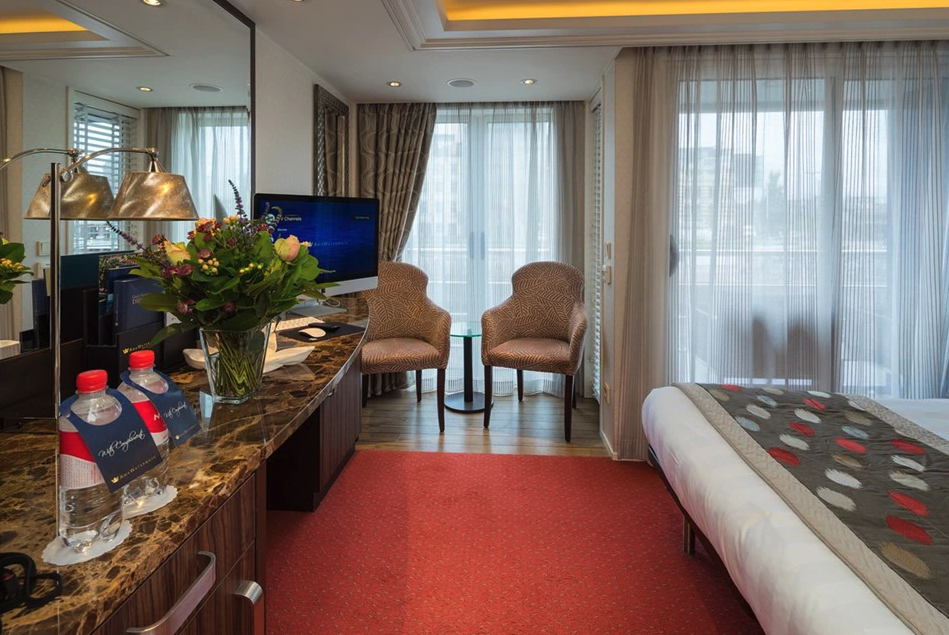
Stateroom Features:
- In-room temperature control
- Deluxe hotel-style bedding with Egyptian linen, down pillows and duvet
- Spacious bathrooms with multi-jet showerheads
- Large wardrobe, full-length mirror, hair dryer, safe and direct-dial telephone
- Flat-screen TV that also works as a computer
- Entertainment on Demand system providing complimentary TV, movies and music library
- Complimentary internet and Wi-Fi
- Complimentary bottled water replenished daily
- Desk and chair
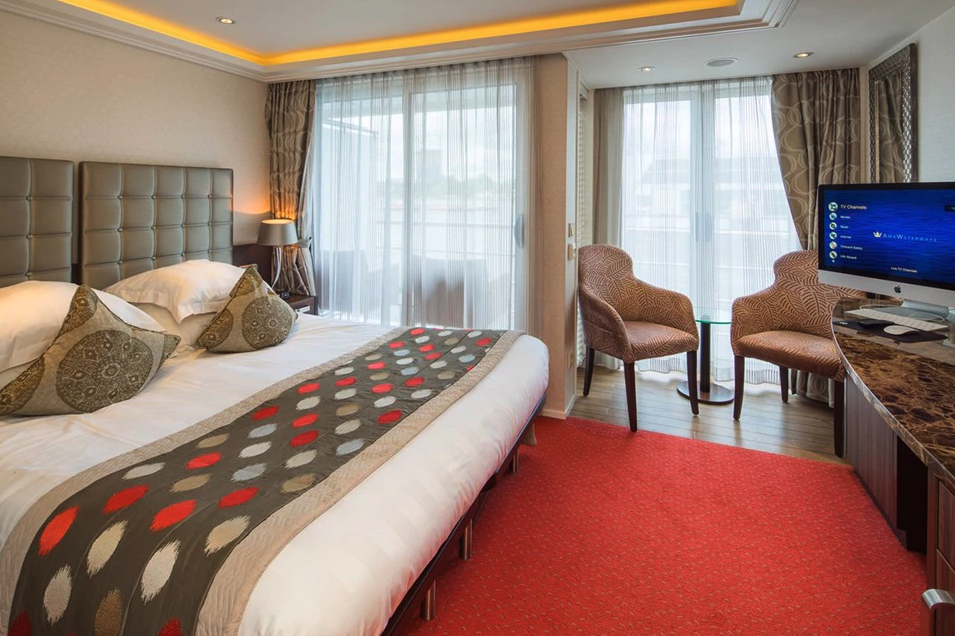
Stateroom Features:
- In-room temperature control
- Deluxe hotel-style bedding with Egyptian linen, down pillows and duvet
- Spacious bathrooms with multi-jet showerheads
- Large wardrobe, full-length mirror, hair dryer, safe and direct-dial telephone
- Flat-screen TV that also works as a computer
- Entertainment on Demand system providing complimentary TV, movies and music library
- Complimentary internet and Wi-Fi
- Complimentary bottled water replenished daily
- Desk and chair
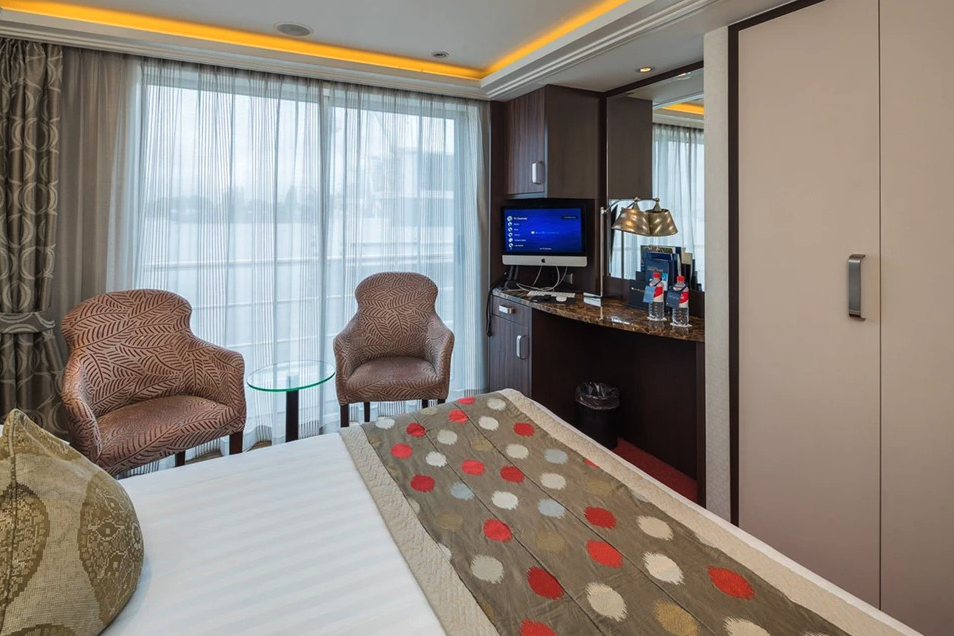
Stateroom Features:
- In-room temperature control
- Deluxe hotel-style bedding with Egyptian linen, down pillows and duvet
- Spacious bathrooms with multi-jet showerheads
- Large wardrobe, full-length mirror, hair dryer, safe and direct-dial telephone
- Flat-screen TV that also works as a computer
- Entertainment on Demand system providing complimentary TV, movies and music library
- Complimentary internet and Wi-Fi
- Complimentary bottled water replenished daily
- Desk and chair
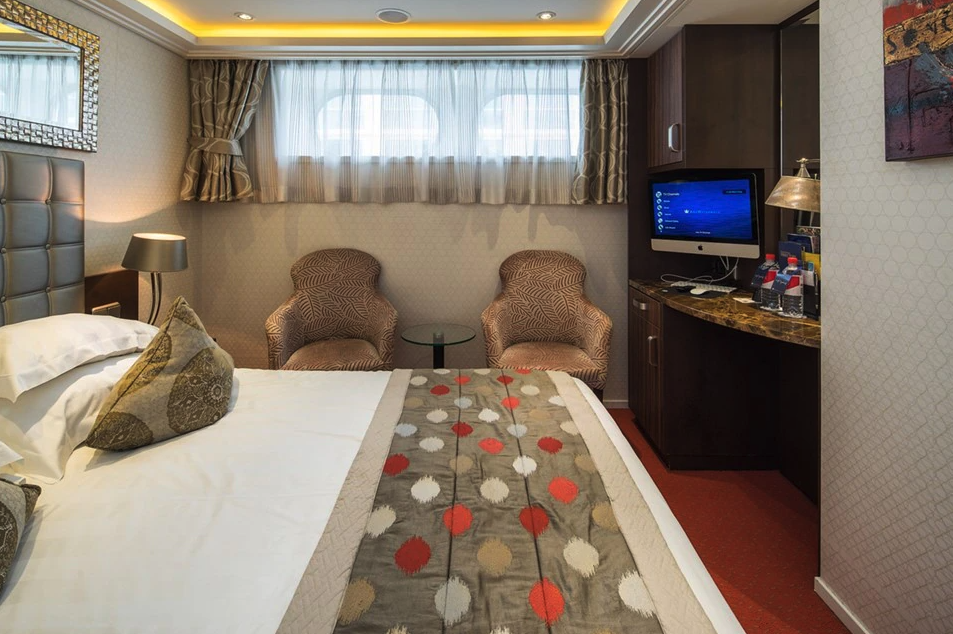
Stateroom Features:
- In-room temperature control
- Deluxe hotel-style bedding with Egyptian linen, down pillows and duvet
- Spacious bathrooms with multi-jet showerheads
- Large wardrobe, full-length mirror, hair dryer, safe and direct-dial telephone
- Flat-screen TV that also works as a computer
- Entertainment on Demand system providing complimentary TV, movies and music library
- Complimentary internet and Wi-Fi
- Complimentary bottled water replenished daily
- Desk and chair

Stateroom Features:
- In-room temperature control
- Deluxe hotel-style bedding with Egyptian linen, down pillows and duvet
- Spacious bathrooms with multi-jet showerheads
- Large wardrobe, full-length mirror, hair dryer, safe and direct-dial telephone
- Flat-screen TV that also works as a computer
- Entertainment on Demand system providing complimentary TV, movies and music library
- Complimentary internet and Wi-Fi
- Complimentary bottled water replenished daily
- Desk and chair
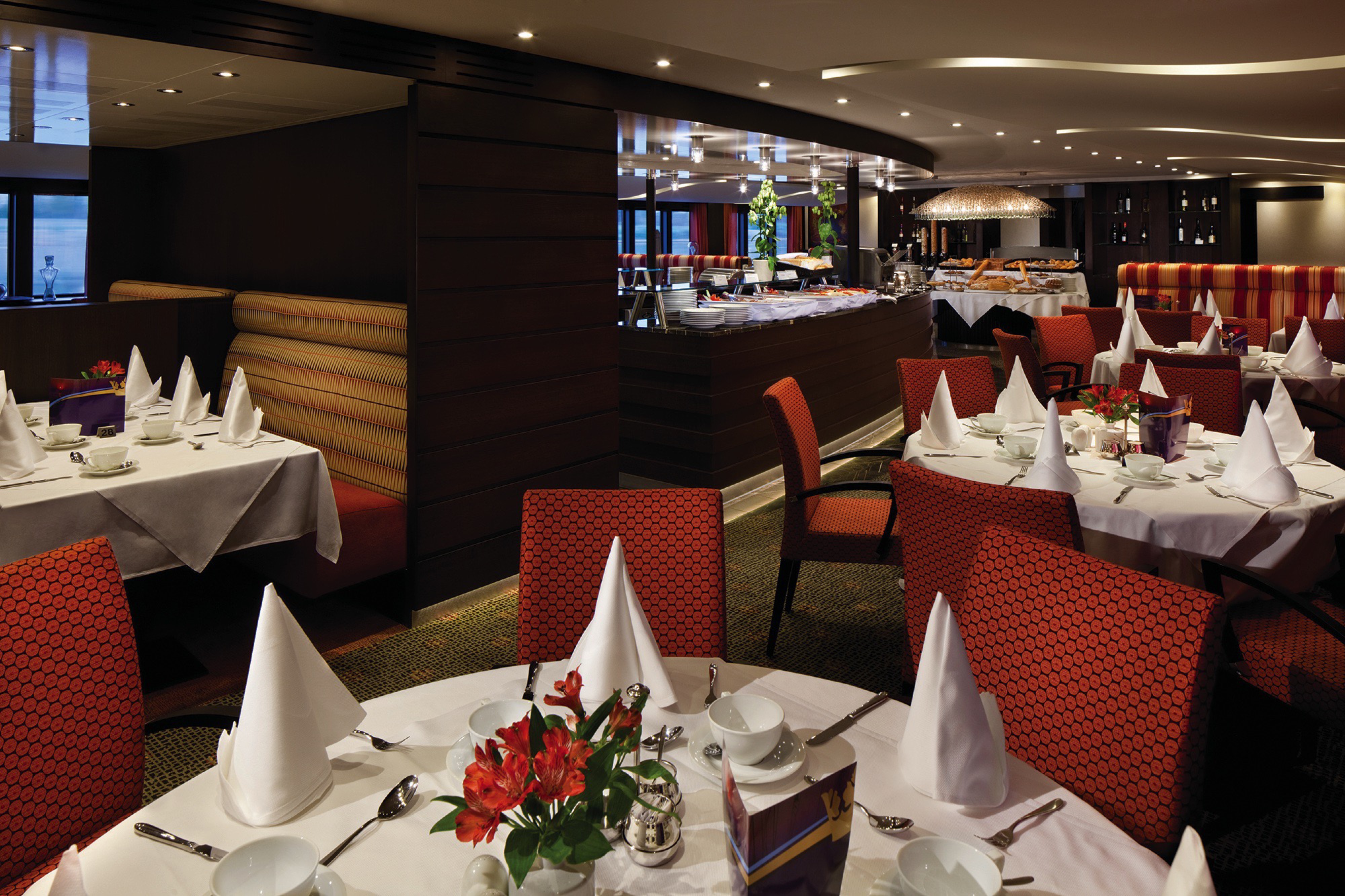
AmaWaterways’ expert chefs craft menus that feature exquisite, locally-inspired cuisine as well as traditional, Western offerings. At breakfast, sip sparkling wine as you partake fresh pastries, or opt for something made-to-order from the menu. Stop by the Main Lounge for a light lunch, or head to the restaurant for full menu service and high-quality regional wine or beer. Dinner is a delectable, multi-course affair with wine recommendations that accompany visually stunning, delicious dishes. Try local favourites — like goulash while cruising through Hungary, bratwurst and sauerkraut after returning to the ship from Vienna, or Camembert cheese while on the Seine — or something more familiar, like a sandwich. No matter what your preference, your taste buds are sure to be impressed.

Join a few of your fellow travellers at The Chef’s Table, where the kitchen — usually hidden — becomes part of the entertainment. You’ll have the opportunity to watch the chef prepare a special multi-course meal right in front of you. The menu here is unique, making this a truly distinct gastronomic experience. Indulge in delectable dishes served with unlimited fine wines, hand-selected just for this dinner. It is the only venue of its kind on the river.
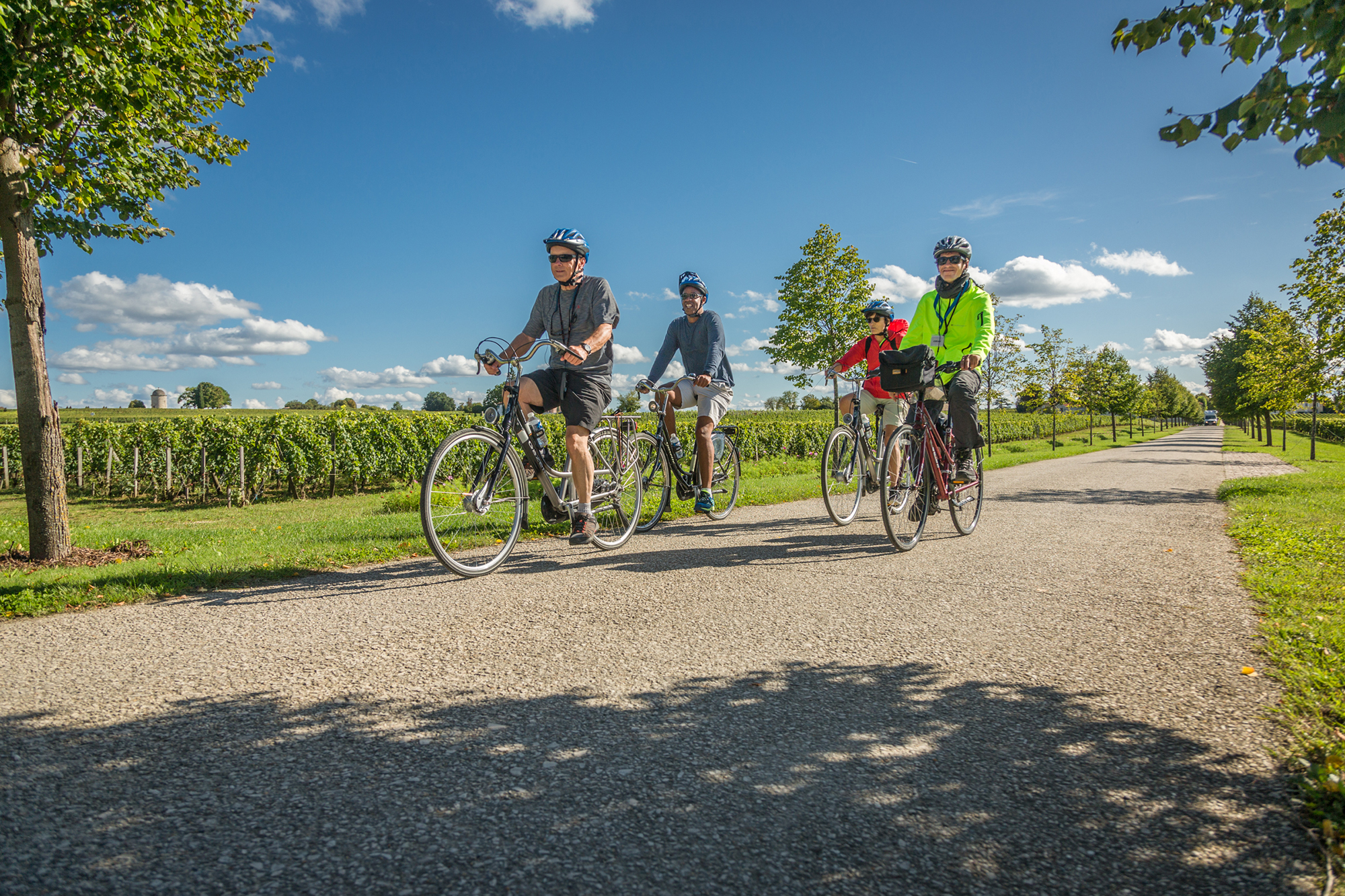
With AmaWaterways, you have the option of exploring Europe’s amazing sights like the locals do. We were the first river cruise line to carry an entire fleet of complimentary bicycles on board, so you can experience biking alongside enchanting riverside pathways and in city centres. Whether you feel like joining one of our exclusive guided bike tours, or want to go discover on your own, there are many ways for you to explore on two wheels during your cruise. Here are a few examples:
- Bike along the beautiful Danube River between Dürnstein and Melk in Austria’s Wachau Valley
- Tour Cologne’s Old Town and Cathedral along the Rhine River
- See the medieval city of Rouen in France’s historic Normandy region, near the Seine River
- Take in wooded hills and beaches of poplars along the scenic shores of the Inn River in Passau
- Go on a guided bike ride in Vienna, where you’ll visit Klosterneuberg Abbey and enjoy cake and coffee

The beauty of Europe doesn’t just lie in its architecture and landmarks – there are also breath taking things to be seen when you venture out into nature. That’s why we’ve designed special hikes that will take you a bit off the beaten path in some very beautiful destinations.
- Trek up to the Veste Oberhaus in Passau, Germany for incredible views over Old Passau
- Make your way up to Dürnstein Fortress, where it is said that Richard the Lionheart was once held captive
- Hike up the Philosopher’s Path to a panoramic view of Heidelberg and the Necker River
- Journey from the ship to the Old Town in Strasbourg, France
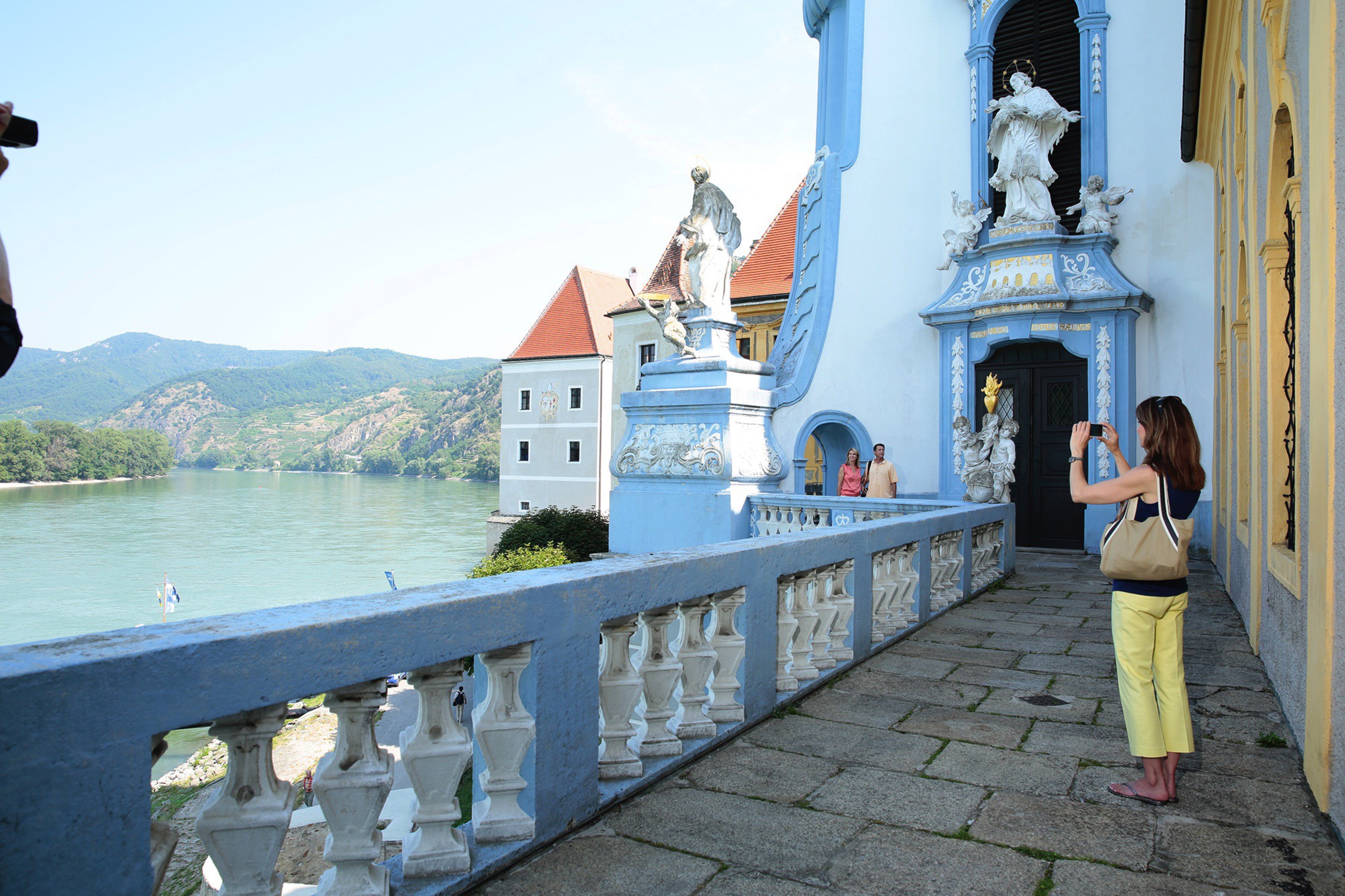
We realise that our guests have different tastes, so we’ve developed a menu of shore excursions in every port of call. In many destinations, you’ll be free to choose from one of several options — all of which are included in your cruise fare. There’s always a city tour designed to show you all the renowned highlights and landmarks in grand capitals and charming villages alike. Is it your first time in Vienna? Opt for an unforgettable exploration of the major sights led by a local, English-speaking guide that is well-versed in history and culture. Have you already been to Nuremberg? Instead of taking the city tour, indulge in a bratwurst and beer tasting on one of our Special Interest Tours, which are specially designed to place you in the midst of local life. We also offer different tour paces: Gentle, regular and active. The choice is yours.
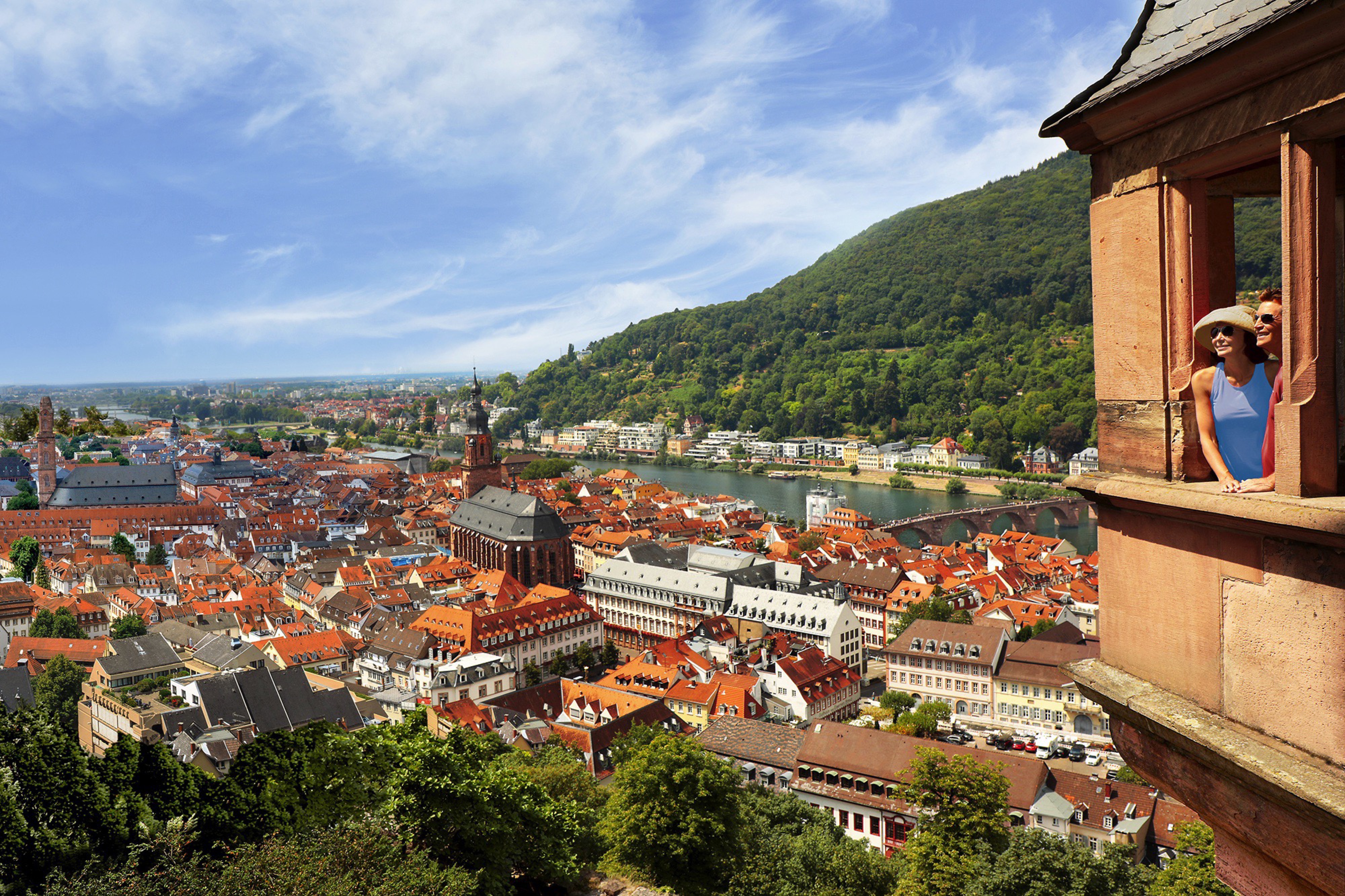
Every year, we seek out new opportunities for our guests to experience local culture in a unique way. These tours are specially designed to give small groups the chance to be even more immersed in a destination. Here are just a few examples:
- Indulge in authentic Belgian waffles and chocolate in Antwerp
- Try your hand at knotting a bretzel (German for “pretzel”) in Wertheim
- Go to a bratwurst and beer tasting at the oldest brewery in Nuremberg
- Discover hidden treasures on a tour of Vienna’s secret spots and sights
- Sample Bavarian specialties like pralines in Regensburg

On an AmaWaterways river cruise, you don’t just pass through a destination — you experience it. Each one of our itineraries is crafted with a paramount goal in mind: connecting you to the essence of life in each place you visit. We always make it a point to place our guests in small groups. This helps facilitate access to sights and landmarks, a more intimate setting, and more encounters with the locals. It’s a great way to take your time as you explore, get to know your fellow travellers better and find opportunities for up-close experiences. Every tour is led by a local, English-speaking guide who is very knowledgeable in the culture and history of the place you are visiting.
Choose your pace: In many cases, you’ll have a choice of gentle, regular and active tour paces. There are even some options for late risers.

This versatile space hosts a bar, dance floor, plenty of comfortable couches and big windows on three sides and is used for everything from the morning port talks, daytime reading and chatting to scenic cruising, afternoon tea and evening entertainment.
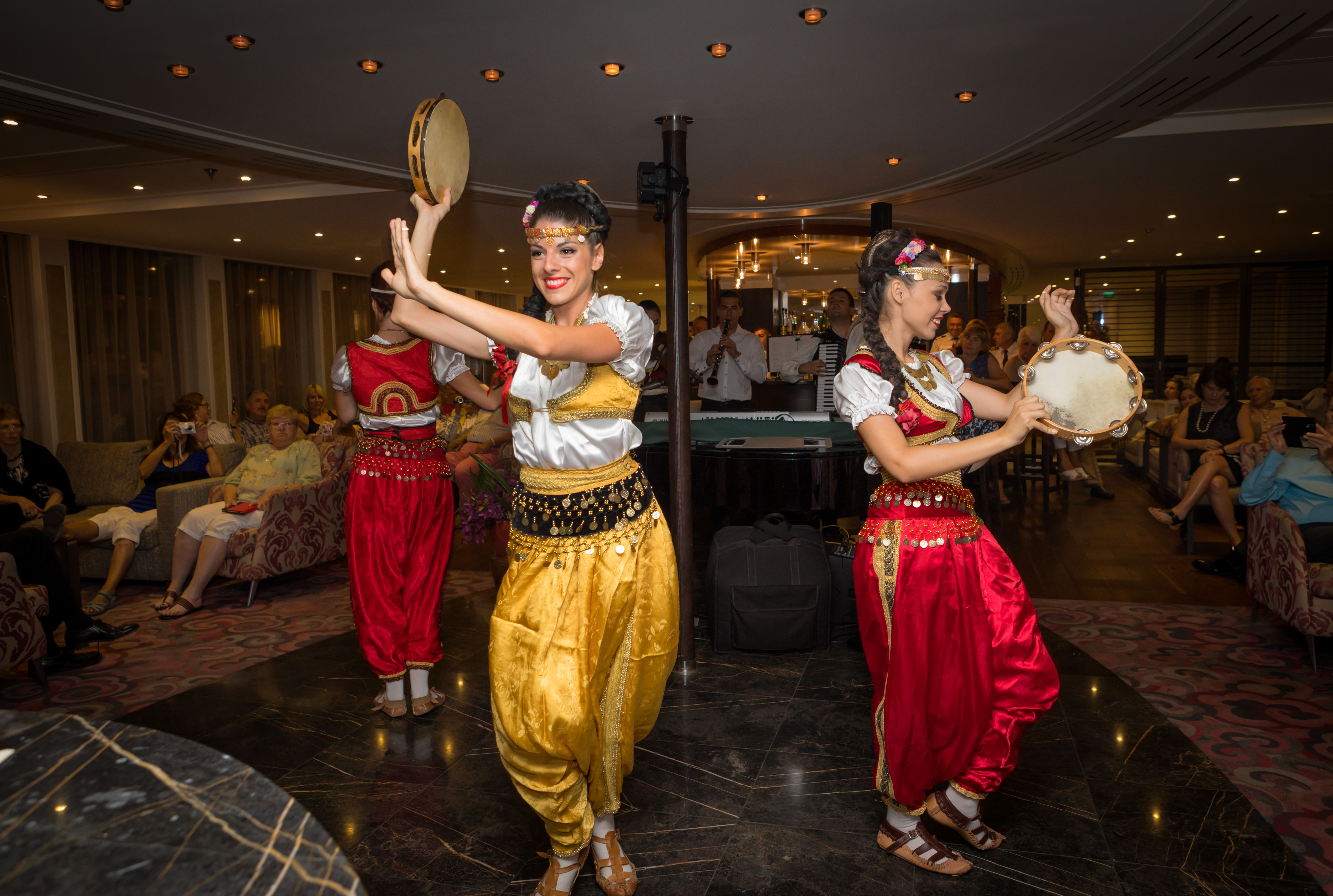
Whether it’s traditional Bavarian music, a local quartet or contemporary piano favourites, you will enjoy an eclectic schedule of onboard entertainment every night.
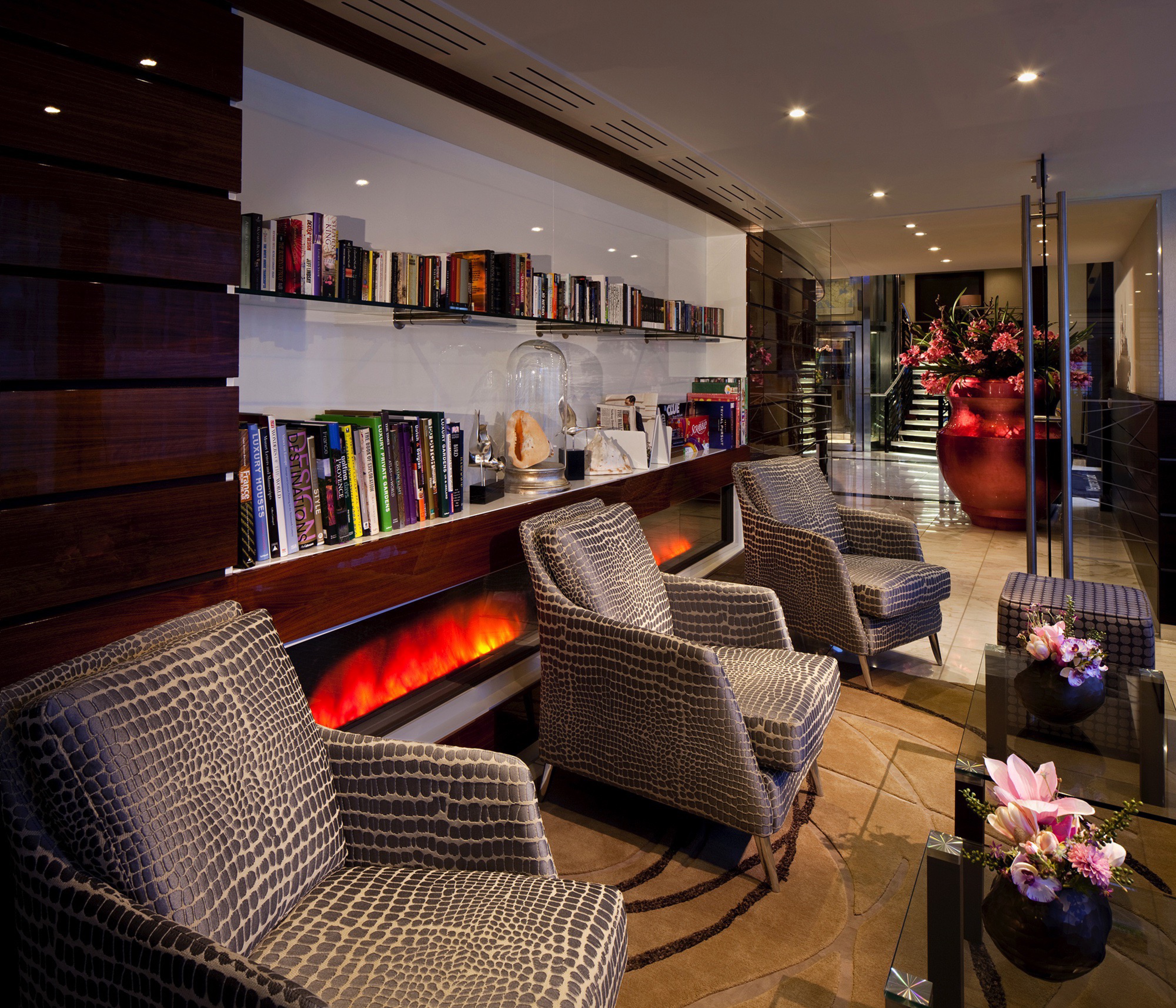
The Library is located on the Violin Deck.
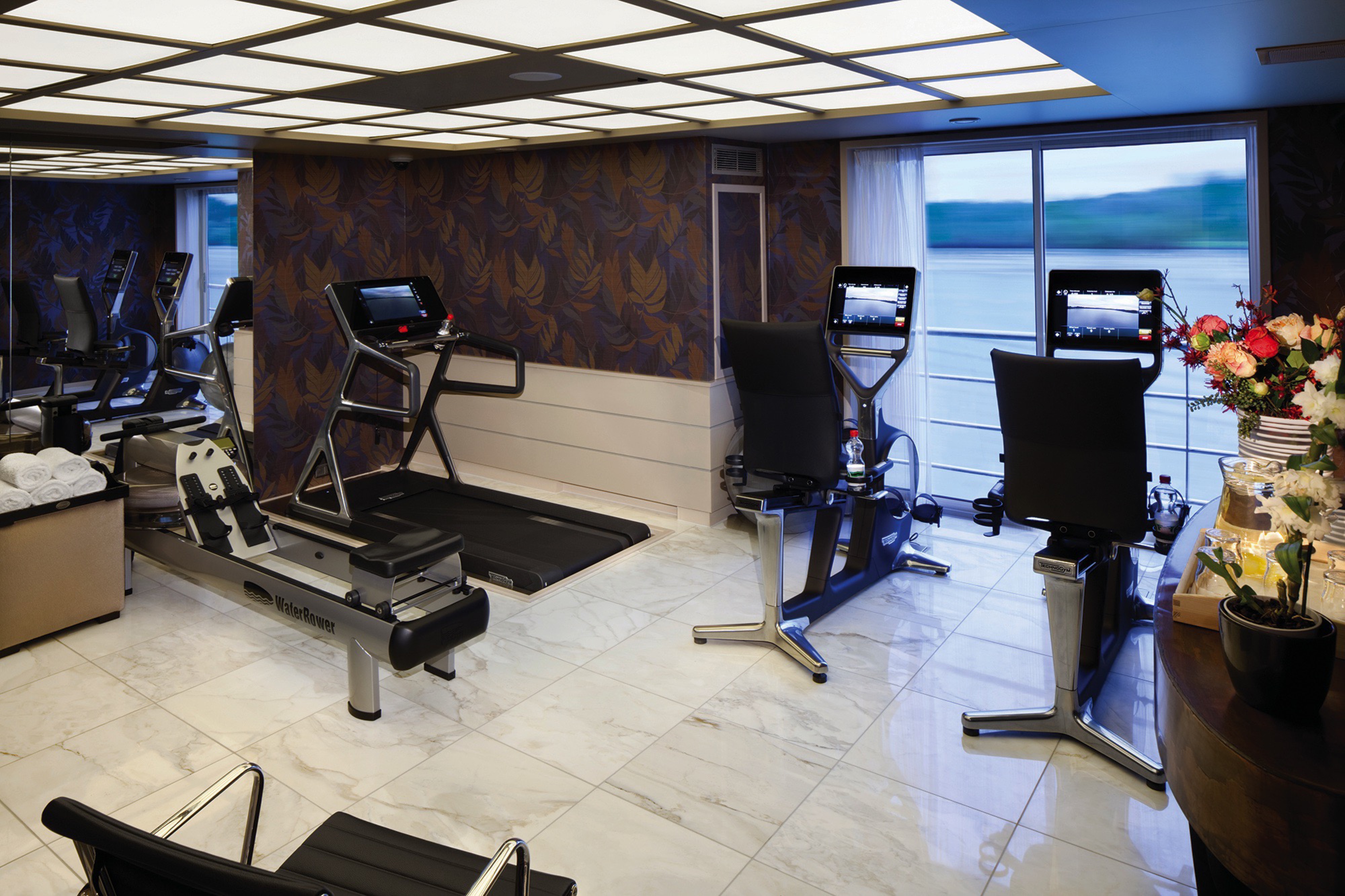
Are you looking for a way to stay fit on vacation? Hit the treadmill or lift some weights while cruising from one destination to the next.

Enjoy the whirlpool on the Sun Deck as we pass by centuries-old castles, charming villages and other breathtaking scenery.
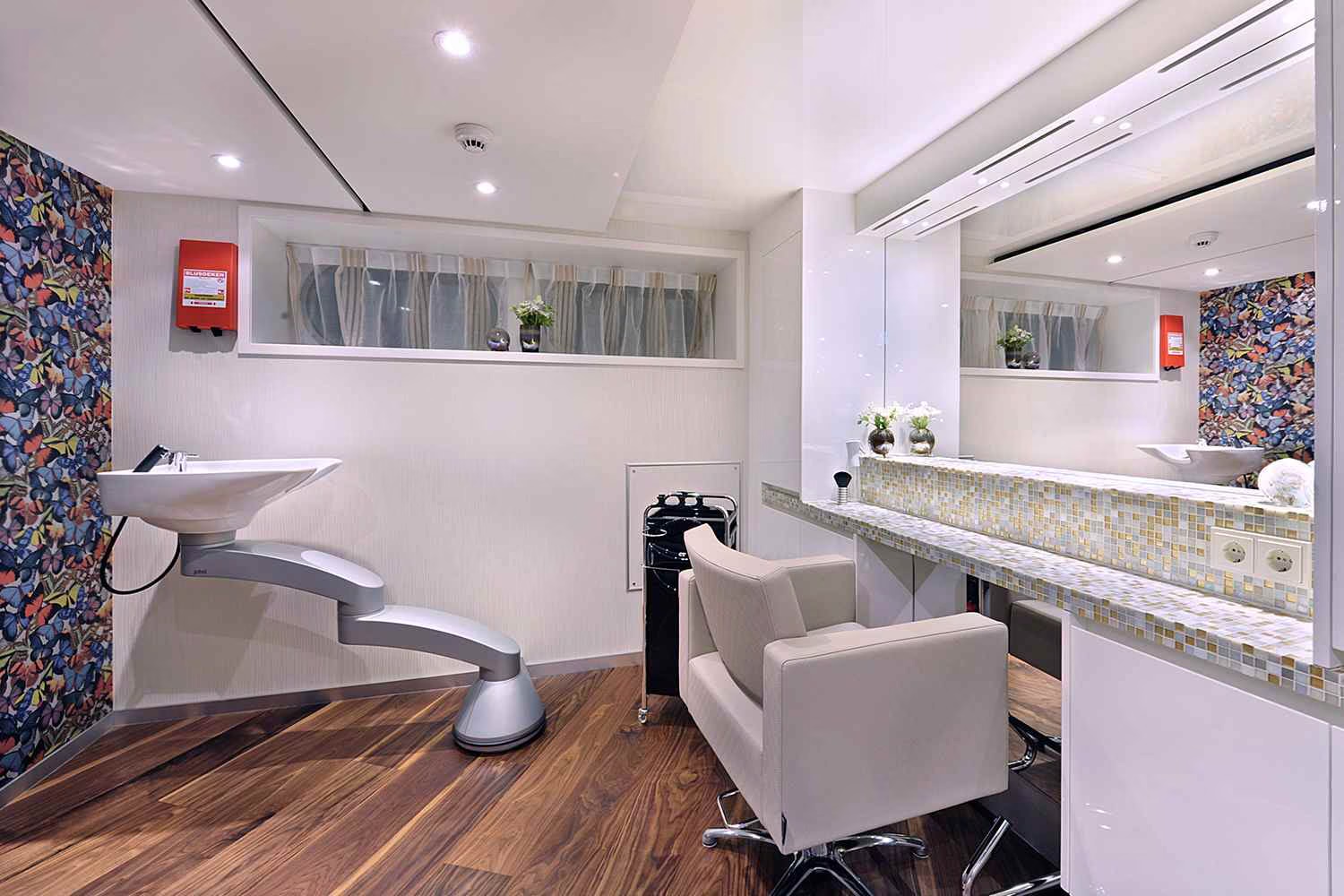
After a marvellous day of immersive shore excursions, return to the ship and treat yourself to a bit of pampering with a soothing massage.
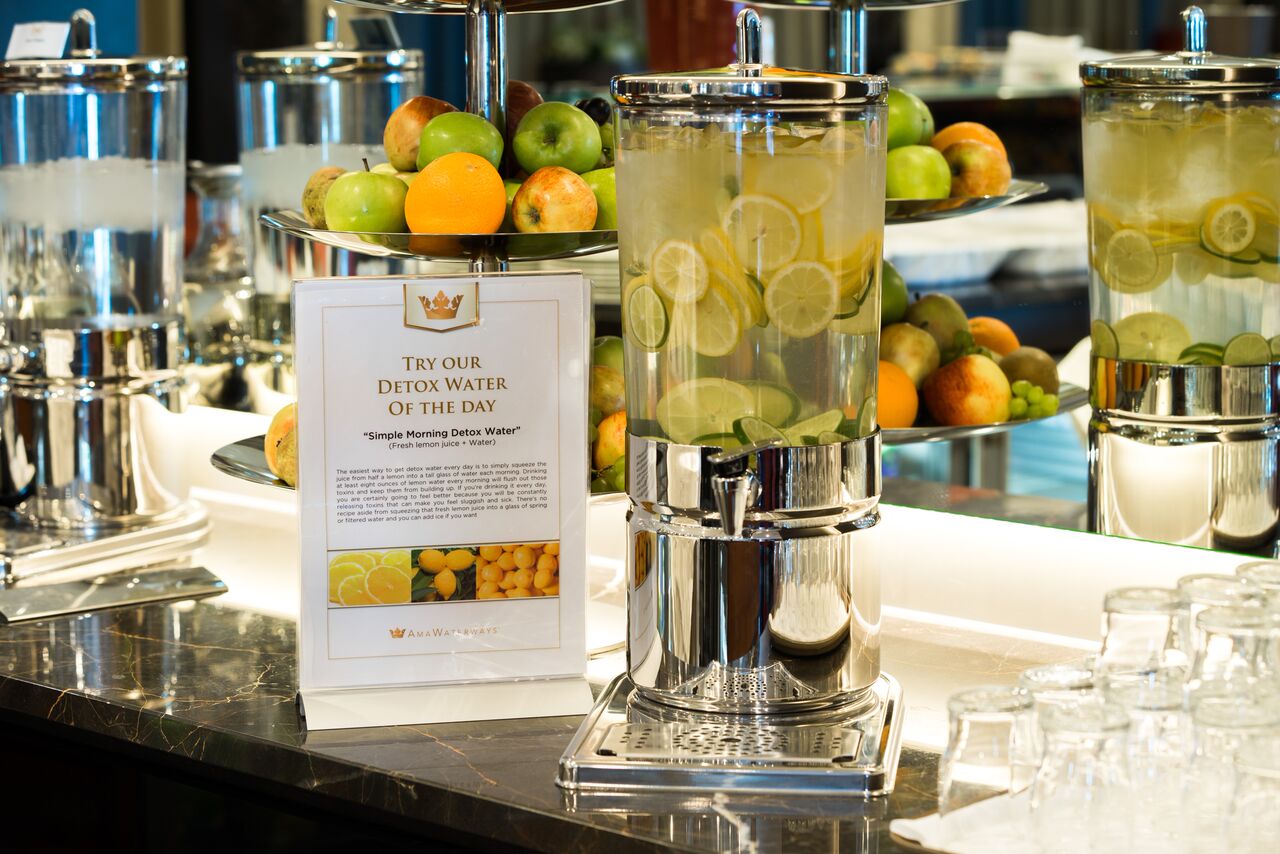
Lighter options are always available during meals as well as gluten free, vegetarian and low-sodium options. Discover the infused detox and gemstone water at our Hydration Station.
All guests under the age of 18 are to be in a stateroom with an adult and must remain supervised at all times; their safety is the responsibility of the accompanying adult(s). In the case where a triple or quad occupancy stateroom is not available or not selected, children under the age of 10 at the time of embarkation may share a stateroom with two adults only in circumstances where the child is able to share the bed with the adults – no additional bed will be provided. Please be aware that balcony staterooms of any kind may be unsafe for minors if left unsupervised. There is a minimum age limit of 4 years old, unless otherwise agreed upon by AmaWaterways.
AmaWaterways does not provide child-specific programs or child-minding facilities. Please reach out to us if you have any further questions regarding our child policy.
Reasonable efforts are made to accommodate the special needs of disabled cruise participants, but no responsibility will be undertaken for any denial of services by carriers, hotels, restaurants, or other independent suppliers. Tour buses are not equipped with wheelchair ramps and cabin doors are not wide enough to allow access by standard wheelchairs.
Wheelchairs and walkers cannot be carried on tour buses, due to space limitations. Wheelchair passengers should be aware of these limitations. For safety reasons, passengers in wheelchairs cannot be carried on ramps in ports where the ship is at anchor. We regret that we cannot provide individual assistance to a tour member for walking, getting on/off tour busses and other transportation vehicles, or other personal needs. A qualified travel companion must accompany travellers who need assistance.
Smoking is not permitted anywhere inside any of the ships. Smoking is only permitted on the Sun Deck. For the safety and comfort of all passengers on board, your cooperation in observing the no-smoking policy is greatly appreciated.
Please advise your Travel Agent or call us directly to advise if you have any dietary restrictions or allergies prior to embarkation. In most cases, we will do our best to accommodate special dietary requests and food allergies, but with one exception: Kosher. This diet has specific rules regarding food and its preparation and the shipboard environment does have limitations that prevent us from being able to adequately cater to this dietary need. Please note, though we can provide options to accommodate food allergies and sensitivities, we cannot guarantee there will not be any cross-contamination.
Comfortable, layered clothing adaptable to changing weather conditions is always advisable for daytime excursions. For the evening, “Casually elegant” attire is recommended and you may want to pack something a little dressier for the Captain’s night/Farewell Dinner – similar to how one would dress to dine at a 5-star restaurant. Comfortable shoes are recommended for excursions and workout clothing if you plan to take part in any wellness activities, active tours or use the onboard gym. Depending on the time of year, clothing that can be layered is highly recommended.
There are no medical facilities on board. However medical services can easily be called from shore if required.
High-speed Internet service is available free of charge as part of the in-stateroom “Entertainment-On-Demand.” Additionally, AmaWaterways offers complimentary Wi-Fi throughout the ship.
Environmentally-Friendly Ship Design
Our river cruise fleet has been thoughtfully designed with eco-friendly elements. These include energy-saving LED lights, special insulated windows that reduce energy needs for heating and cooling, power locks to plug into a port’s power supply instead of running generators, solar heating systems, water treatment plants that provide microfiltration and recycling of all water used on board. AmaMagna also has an innovative 10-engine configuration designed to reduce fuel consumption and solar panels have been installed on all stateroom balconies. In addition, the Zambezi Queen uses a water jet propulsion system that protects the Chobe riverbed, water-saving taps and showers, biodegradable detergents and soaps, and a five-stage water purification plant.
A Greener Onboard Experience
To reduce overall plastic consumption, we use paper straws (upon request), refillable glass water bottles in all staterooms, and hand out recyclable tetra-pak water containers for excursions across the fleet (where available). We have lessened unnecessary food waste from large-scale buffets by serving a la carte lunches on board our European fleet. For our personal audio devices used on excursions, we are proud to partner with Quietvox, which utilizes biodegradable rice paper bags and rechargeable batteries. In addition, our luggage tags and handy travel wallets are both made from recycled plastic bottle material and are now delivered to guest staterooms on board our ships in Europe, reducing our carbon footprint. The usage of our innovative myAmaCruise app and electronic travel documents has also significantly reduced paper consumption both pre-cruise and on board.

- Lower Sun Deck
- Navigation Bridge
- Bicycles
- Heated Pool
- Sun Deck
- Walking Track
- Wheelhouse

- Al Fresco Dining Terrace
- Observation Lounge
- Main Lounge & Bar
- Gift Shop
- Reception
- Fitness Room
- Massage & Hair Salon
- The Chef’s Table Restaurant
- Suite
- Cat. AA+ French & Outside Balcony Staterooms
- Cat. AA French & Outside Balcony Staterooms
- Cat. BA French & Outside Balcony Staterooms
- Cat. C French Balcony Staterooms
- Elevator

- Main Restaurant
- Elevator
- Cat. BB French & Outside Balcony Staterooms
- Cat. AB French & Outside Balcony Staterooms
- Cat. C French Balcony Staterooms
- Elevator

- Cat D Fixed Window Staterooms
- Cat E Fixed Window Staterooms
- Crew Cabins

